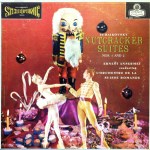Decca and London Hot Stamper Pressings Available Now
Making Audio Progress Is Key to Finding Better Records
Many London and Decca pressings lack weight down low, which thins out the sound and washes out the lower strings.
On some sides of some copies the strings are dry, lacking Tubey Magic. This is decidedly not our sound, although it can easily be heard on many London pressings, the kind we’ve played by the hundreds over the years.
If you have a rich sounding cartridge, perhaps with that little dip in the upper midrange that so many moving coils have these days, you will not notice this tonality issue nearly as much as we do.
Our 17Dx is ruler flat and quite unforgiving in this regard. It makes our shootouts much easier, but brings out the flaws in all but the best pressings, exactly the job we require it to do.
Here are some other records that are good for testing string tone and texture.
 If you have vintage equipment, you never have to worry about the strings on your London orchestral recordings sounding too dry.
If you have vintage equipment, you never have to worry about the strings on your London orchestral recordings sounding too dry.
You haven’t solved the problem, obviously. You’ve just made it much more difficult — impossible even — to hear what is really on your records.
Some audiophiles have gone down this road and may not even realize what road they are on, or where it leads. Assuming you want to make progress in this hobby, it is a dead end, If you want to find Better Records, you need equipment that can distinguish good records from bad ones.
Vintage tube equipment is good for many things, but helping  you find the best sounding records is not one of them.
you find the best sounding records is not one of them.
A rack full of equipment such as the one shown here — I suspect it is full of transistors but it really doesn’t matter whether it is or not — is very good at eliminating the subtleties and nuances that distinguish the best records from the second- and third-rate ones.
If you have this kind of electronic firepower, Heavy Vinyl pressings and Half-Speed Mastered LPs don’t sound nearly as irritating as they do to those of us without the kind of filtering you get with this kind of electronic overkill.
In my experience, this much hardware can’t help but get between you and the music you are playing.
It may be new and expensive, but the result is the kind of old school stereo sound I have been hearing all my life.
 The “in-groove” guy you see to the left is the poster child for mistaking a rack of expensive components for the kind that can tell him how bad some records are, the Mobile Fidelity Kind of Blue in this case, which is very bad indeed. (Review coming someday we promise.)
The “in-groove” guy you see to the left is the poster child for mistaking a rack of expensive components for the kind that can tell him how bad some records are, the Mobile Fidelity Kind of Blue in this case, which is very bad indeed. (Review coming someday we promise.)
We assume our customers can hear it — our good customer Conrad had no problem appreciating its shortcomings — but we are pretty sure our customers can recognize a good record from a bad one, otherwise they would not see the value in Hot Stampers, right?
But the blue lights look awesome, the stuff costs a fortune, and for those with better eyes than ears, it’s impressive as hell.
Good equipment is necessary but far from sufficient to get good sound, a subject we discuss here and at some length throughout the blog in our commentaries about audio equipment.
Why Are Some Common Subjects Concerning the Sound of Recordings Rarely Discussed?
Can we really be hearing all these characteristics of recordings that nobody else seems to be hearing? A few examples:






 More of the Music of Jacques Offenbach (1819-1880)
More of the Music of Jacques Offenbach (1819-1880)



